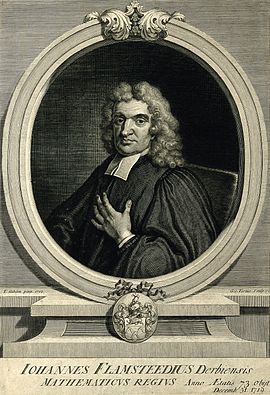John Flamsteed
John Flamsteed (19 August 1646 in Denby, Derbyshire, England - 31 December 1719 in Greenwich, England) was a British astronomer, First Astronomer Royal, who was in charge of the Creation of the Royal Greenwich Observatory. He is the author of the stellar catalog Atlas Coelestis.
Biography
He was ordained a deacon and was preparing to settle in Derbyshire when he was invited to London. On March 4, 1675, he was appointed, by royal decree, "King's Astronomical Observer"; —the first British Astronomer Royal—with an endowment of £100 a year. In June 1675 another royal decree provided for the establishment of the Greenwich Observatory, with Flamsteed laying the first stone in August of that year. In February 1676, he was admitted to membership in the Royal Society, and in July he moved to the observatory, where he lived until 1684, when he was finally ordained as minister of the parish of Burstow, Surrey. He held said position, as well as that of & # 34; Royal Astronomer & # 34;, until his death. He was buried in Burstow.
He accurately calculated the solar eclipses of 1666 and 1668. He was responsible for one of the first observations of the planet Uranus, despite mistaking it for a star and cataloging it as “34 Tauri”.
In 1672 he made delicate observations to determine the value of the solar parallax: the one he obtained was equal to 10" (actual value is 8.79").
On August 16, 1680, he cataloged a star as 3 Cassiopeiae, the existence of which later astronomers could not corroborate. Three hundred years later, the American astronomical historian William Ashworth suggested that what Flamsteed would likely have seen was a supernova, an explosion that would have produced the most powerful source of radio waves outside our solar system, known in the Third Cambridge Catalog as 3C. 461, commonly called Cassiopeia A by astronomers. Because the position of "3 Cassiopeia" does not exactly match that of "Cassiopeia A", since the expansion wave has been traced to 1667, and not 1680, some historians think that Flamsteed did miscalculate the position of an already known star.
He is also remembered for his conflicts with Isaac Newton, the then president of the Royal Society, who tried to steal some of Flamsteed's discoveries for his own work. Newton misled Flamsteed by using an edict from the king, and published the findings without crediting Flamsteed. Some years later, Flamsteed managed to buy most of the copies of said book, and publicly burned them in front of the Royal Observatory.
He worked for several years on a catalog of stars, which he published in 1707. In 1725 he published Historia Coelestis Britannica, a work that, partly posthumously, contained his observations for the period 1675-1719, including a catalog of nearly 3,000 stars significantly more accurate than any previous work, as well as the Ptolemy and Landgrave catalogues. This was considered the first significant contribution of the Greenwich Observatory.
Honors
- The asteroid 4987 Flamsteed
- Elect Member of the Royal Society in 1676
- The Flamsteed crater on the Moon bears this name in his honor
- The John Flamsteed Community School in Denby, Derbyshire, was named in her honor
Contenido relacionado
(39) Laetitia
(116) Sirona
(8) Flora
